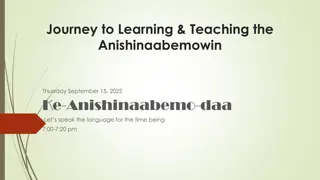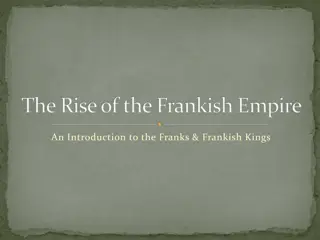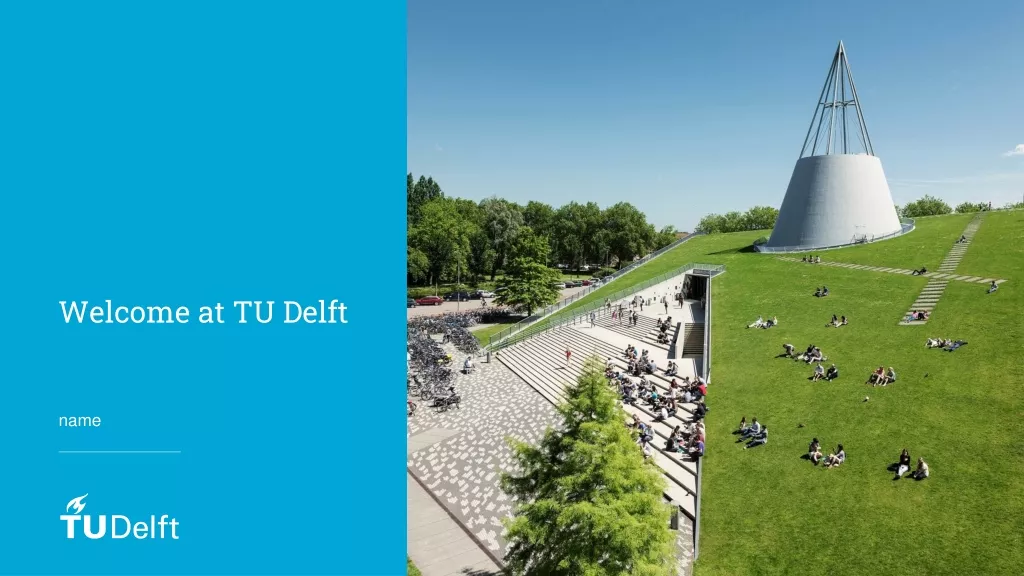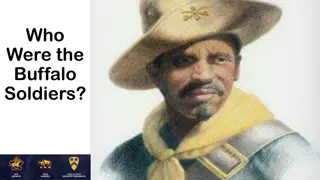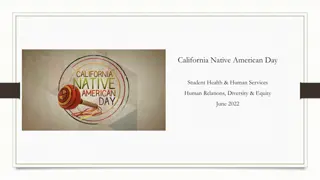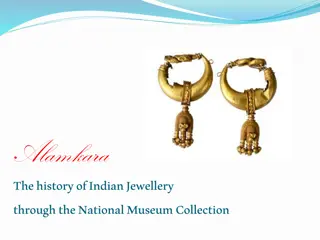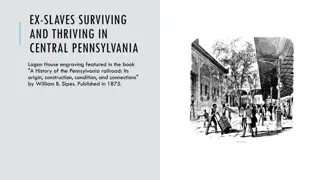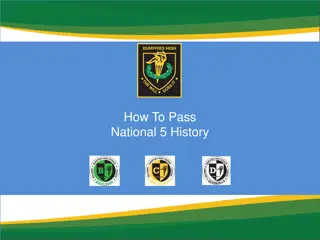Anishinabek Journey Through History
Explore the rich history of the Anishinabek people, who have lived in Michigan since ancient times. Discover their cultural heritage and migration westward through captivating images and maps. Delve into the transportation methods they may have used for their journey.
Download Presentation

Please find below an Image/Link to download the presentation.
The content on the website is provided AS IS for your information and personal use only. It may not be sold, licensed, or shared on other websites without obtaining consent from the author. Download presentation by click this link. If you encounter any issues during the download, it is possible that the publisher has removed the file from their server.
E N D
Presentation Transcript
The Anishinabek in the Past 1 This work is licensed under a Creative Commons Attribution-NonCommercial-ShareAlike 4.0 International License
Northeast Southeast Eastern Woodlands Region The Eastern Woodlands was a cultural area of Indigenous people of North America. It was often divided into the Northeast and Southeast regions. 2 This work is licensed under a Creative Commons Attribution-NonCommercial-ShareAlike 4.0 International License
Northeast Southeast Eastern Woodlands Region Tribal Nations of this region shared many cultural traits. The Anishinabek of the Great Lakes were part of this region. 3 This work is licensed under a Creative Commons Attribution-NonCommercial-ShareAlike 4.0 International License
The Anishinabek are some of the very first people to have lived in Michigan. They have lived in Michigan since time immemorial. 4 This work is licensed under a Creative Commons Attribution-NonCommercial-ShareAlike 4.0 International License
5 This work is licensed under a Creative Commons Attribution-NonCommercial-ShareAlike 4.0 International License
Originally the Anishinabek lived along the ocean near where the star is located. Long, long ago they migrated toward the west. Map courtesy of the Michigan Geographic Alliance 6 This work is licensed under a Creative Commons Attribution-NonCommercial-ShareAlike 4.0 International License
What kind of transportation do you think the Anishinabek used to make this journey? Map courtesy of the Michigan Geographic Alliance 7 This work is licensed under a Creative Commons Attribution-NonCommercial-ShareAlike 4.0 International License
1. What kind of transportation do you think the Anishinabek used to make this journey? 8 This work is licensed under a Creative Commons Attribution-NonCommercial-ShareAlike 4.0 International License
The Anishinabek traveled along the waterways by canoe. It was faster than walking and cars had not yet been invented! Canoes are strong, lightweight and able to carry very heavy loads. A 36 foot freight canoe, for example, can carry 6000 pounds. 9 This work is licensed under a Creative Commons Attribution-NonCommercial-ShareAlike 4.0 International License
They made several stops along the way. One was described by the Anishinabek as the place where thunder and water met . Question 2: What place do you think they were describing? 10 This work is licensed under a Creative Commons Attribution-NonCommercial-ShareAlike 4.0 International License
The Anishinabek were describing Niagara Falls. They described the sound the water makes as it rushes over the edge and crashes to the bottom. It sounds a lot like thunder. 11 This work is licensed under a Creative Commons Attribution-NonCommercial-ShareAlike 4.0 International License
The next main stop was where the city of Detroit, Michigan, is now. Not everyone came this far. Some families stopped in other places and made their home along the way. 12 This work is licensed under a Creative Commons Attribution-NonCommercial-ShareAlike 4.0 International License
From here the Anishinabek spread throughout the Great Lakes region. 13 This work is licensed under a Creative Commons Attribution-NonCommercial-ShareAlike 4.0 International License
The entire Great Lakes region became home to the Anishinabek. Map courtesy of the Michigan Geographic Alliance 14 This work is licensed under a Creative Commons Attribution-NonCommercial-ShareAlike 4.0 International License
Anishinabek Aki Land of the Anishinabek In their language, Anishinaabemowin, the region is called Anishinabek Aki. Map courtesy of the Michigan Geographic Alliance 15 This work is licensed under a Creative Commons Attribution-NonCommercial-ShareAlike 4.0 International License
The forests and waterways of this region have always been very important to the Anishinabek. 16 This work is licensed under a Creative Commons Attribution-NonCommercial-ShareAlike 4.0 International License
Geography Where you live 17 This work is licensed under a Creative Commons Attribution-NonCommercial-ShareAlike 4.0 International License
landforms waterways climate Geography Where you live animals plants 18 This work is licensed under a Creative Commons Attribution-NonCommercial-ShareAlike 4.0 International License
landforms waterways climate Geography Culture Where you live How you live animals plants 19 This work is licensed under a Creative Commons Attribution-NonCommercial-ShareAlike 4.0 International License
landforms food homes clothing waterways climate Geography Culture Where you live How you live animals knowledge plants transportation 20 This work is licensed under a Creative Commons Attribution-NonCommercial-ShareAlike 4.0 International License
3. What type of houses do you think the Anishinabek lived in a long time ago? Tipi Pueblo Wigwam 21 This work is licensed under a Creative Commons Attribution-NonCommercial-ShareAlike 4.0 International License
The correct answer is Wigwam A wigwam is made by covering a wooden frame with bark. Birch bark is often used. 22 This work is licensed under a Creative Commons Attribution-NonCommercial-ShareAlike 4.0 International License
The Anishinabek use birch trees for many other things besides a covering for their homes. 23 This work is licensed under a Creative Commons Attribution-NonCommercial-ShareAlike 4.0 International License
Birch bark is used to make canoes. It is also used to make baskets and bowls. 24 This work is licensed under a Creative Commons Attribution-NonCommercial-ShareAlike 4.0 International License
4. What do you think the Anishinabek ate a long time ago and still eat today? A B Sturgeon Biscuits Wild Rice C 25 This work is licensed under a Creative Commons Attribution-NonCommercial-ShareAlike 4.0 International License
The correct answer is and A B Sturgeon have always been one of the most important fish to the Anishinabek. In the Anishinabek language, Anishinaabemowin, they are called Nme . A Sturgeon (Nme') 26 This work is licensed under a Creative Commons Attribution-NonCommercial-ShareAlike 4.0 International License
The Anishinabek call the Sturgeon the Chief fish or the grandfather of all fish. This is because the Sturgeon has always been seen as the leader of all the fish and is the oldest, as well as largest. 27 This work is licensed under a Creative Commons Attribution-NonCommercial-ShareAlike 4.0 International License
The correct answer is and A B B Wild Rice has always been known to the Anishinabek as Manoomin which means good berry. It still is an important food source. Wild Rice (Manoomin) 28 This work is licensed under a Creative Commons Attribution-NonCommercial-ShareAlike 4.0 International License
Wild Rice grows in water. The Anishinabek still use canoes to harvest it in fall. 29 This work is licensed under a Creative Commons Attribution-NonCommercial-ShareAlike 4.0 International License
5. The Anishinabek moved seasonally to different locations. Why do you think they did this? Biboon (winter) Dagwaagin (fall) Ziigwan (spring) Niibin (summer) 30 This work is licensed under a Creative Commons Attribution-NonCommercial-ShareAlike 4.0 International License
The Anishinabek moved seasonally to different locations based on the activities they were doing. These activities met their needs and followed the circle of the seasons. Biboon (winter) Dagwaagin (fall) Ziigwan (spring) Niibin (summer) 31 This work is licensed under a Creative Commons Attribution-NonCommercial-ShareAlike 4.0 International License
32 This work is licensed under a Creative Commons Attribution-NonCommercial-ShareAlike 4.0 International License
In spring many Anishinabek moved to their sugar camps. They collected sap from maple trees and made maple syrup and sugar. Some moved to summer garden sites to start preparing gardens and plant seeds. Ziigwan (spring) 33 The Sugar Camp Exhibit at Ziibiwing Center of Anishinabe Culture & Lifeways Maple Sugar 33 This work is licensed under a Creative Commons Attribution-NonCommercial-ShareAlike 4.0 International License
In summer the Anishinabek returned to their summer villages. They tended to crops like corn, beans and squash. They harvested and dried summer berries and other plants. Ziigwan (spring) Niibin (summer) 34 This work is licensed under a Creative Commons Attribution-NonCommercial-ShareAlike 4.0 International License
In fall the Anishinabek were very busy harvesting and preparing for winter. Dagwaagin (fall) Ziigwan (spring) Some would travel to the area where they harvested Wild Rice. Niibin (summer) Some would stay at the summer garden site to harvest crops. Others hunted and fished. 35 This work is licensed under a Creative Commons Attribution-NonCommercial-ShareAlike 4.0 International License
In the winter large Anishinabek groups broke into smaller family groups. These small groups moved to their winter camps. Biboon (winter) Dagwaagin (fall) Ziigwan (spring) These camps were usually in wooded areas where there was some protection from the winter weather. Niibin (summer) They got what they needed by ice fishing, trapping animals like beaver and hunting animals like deer. This was also the time for storytelling. 36
4 2 1 3 37 This work is licensed under a Creative Commons Attribution-NonCommercial-ShareAlike 4.0 International License
Some Anishinabek activities were part of daily living. They were done in all seasons. What do you think some of these activities were? Biboon (winter) Gathering firewood and water Hunting, fishing and gathering Dagwaagin (fall) Ziigwan (spring) Niibin (summer) Teaching, sharing knowledge and having ceremonies 38
Important parts of Anishinabek culture 39 This work is licensed under a Creative Commons Attribution-NonCommercial-ShareAlike 4.0 International License
Important Teachings in Anishinabek Culture MANAADJITOWAAWIN (Respect) Give respect to everyone, all human beings and all things created 40 40 This work is licensed under a Creative Commons Attribution-NonCommercial-ShareAlike 4.0 International License
Important Teachings in Anishinabek Culture MANAADJITOWAAWIN (Respect) Give respect to everyone, all human beings and all things created AAKODEWIN (Bravery) To be brave; we should have the courage to do what is right for ourselves and for others 41 41 This work is licensed under a Creative Commons Attribution-NonCommercial-ShareAlike 4.0 International License
Important Teachings in Anishinabek Culture MANAADJITOWAAWIN (Respect) Give respect to everyone, all human beings and all things created AAKODEWIN (Bravery) To be brave; we should have the courage to do what is right for ourselves and for others NIBWAAKAAWIN (Wisdom) Gain knowledge and learning from experiences 42 42 This work is licensed under a Creative Commons Attribution-NonCommercial-ShareAlike 4.0 International License


